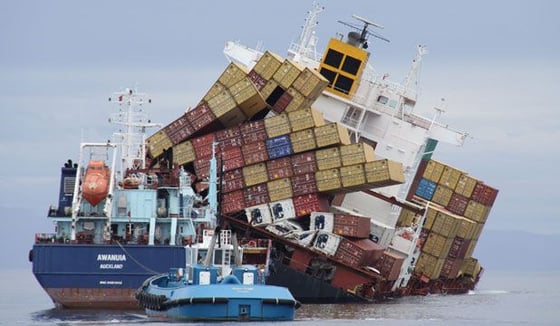The International Trade Blog Shipping Solutions Software
New Weight Verification Requirements Coming in July 2016
On: March 8, 2016 | By:  Lisa Nemer |
3 min. read
Lisa Nemer |
3 min. read
 We’ve all seen the pictures: container ships listing to one side with stacks of containers ready to topple into the ocean. One reason for this harrowing situation could be that the container weights were incorrectly reported to the vessel operator loading the ship. While a small discrepancy is not going to cause ship instability or collapsed container stacks, the discrepancies can add up.
We’ve all seen the pictures: container ships listing to one side with stacks of containers ready to topple into the ocean. One reason for this harrowing situation could be that the container weights were incorrectly reported to the vessel operator loading the ship. While a small discrepancy is not going to cause ship instability or collapsed container stacks, the discrepancies can add up.
According to the World Shipping Council, Ukraine Customs weighed all containers over a two week period in 2012 and found that 56% of the containers weighed more than the weight stated in the carrier’s cargo manifest. Because of findings like this, in 2014 the International Maritime Organization (IMO) amended the Safety of Life at Sea (SOLAS) Convention to put into place stricter rules for verifying container weights.
New Weight Verification Requirements
The SOLAS Convention is applicable global law, and the new amendments become effective on July 1, 2016. The amendments require that the shipper of a packed container provide a Verified Gross Weight (also referred to as Verified Gross Mass) to the ocean carrier prior to it being loaded onto a ship, no matter who packed the container. Terminal operators are forbidden from loading a packed container aboard a vessel for export without the Verified Gross Weight of the container.
Two Weighing Methods
There are two approved methods for determining the Verified Gross Weight. Method one is to weigh the container plus its contents once it has been packed. This method will require a scale, weighbridge or lifting equipment that meet the applicable accuracy standards and requirements of the state in which the equipment is being used. The shipper may arrange to have a third party weigh the container for them.
Method two requires the shipper (or an arranged third party) to weigh all the items to be packed in the container separately, including the pallets and other packing materials. The weights of the items can then be added to the weight of the shipping container, which is shown on the exterior of the container. Again the weighing equipment must meet state accuracy standards.
Reporting the Verified Gross Weight
Once the Verified Gross Weight is determined, it must be reported. It can be communicated on any document, such as the shipping instructions to the shipping company or a separate declaration that may also include a weight certificate from a weigh station using calibrated and certified equipment. The weight must be labeled “verified gross mass.” For U.S. exports, the weight should be expressed in pounds.
Whatever form the document takes it must be signed by a duly authorized representative of the shipper. The shipper is defined as the company or person named on the Ocean Bill of Lading as shipper. It can be an electronic signature or just the name in all capital letters. If the port terminal is uncertain about the accuracy of the weight, they can weigh the container again and use the new weight for vessel planning.
Using Shipping Solutions to Report Verified Gross Weight
So how is Shipping Solutions planning to handle this change in regulations? Because there is no prescribed document to report the Verified Gross Mass, we have no plans at this time to add a new document. The Gross Weight is already shown on the Packing List. We would suggest adding a statement to the Packing List Special Instructions that reads something like, “The Gross Weight shown above is the Verified Gross Mass,” if indeed you are able to make that declaration.
However, we are always open to feedback from our customers. If you have specific ideas for changes to Shipping Solutions to help you comply with the new SOLAS amendment, please give me a call at 651-905-1727 or email help@shipsolutions.com.
Additional Resources
Below are some additional resources from the World Shipping Council that you might find useful:
- Guidlines for Improving Safety and Implementing SOLAS Container Weight Verification Requirements
- The SOLAS Container Weight Verification Requirement
- Verified Gross Mass Industry FAQs

About the Author: Lisa Nemer
Lisa Nemer leads the customer service and finance teams at Shipping Solutions, a software company that develops and sells export document and compliance software targeted specifically at small and mid-sized U.S. companies that export. If you have ever called Shipping Solutions with a question or problem you've probably talked to Lisa! Prior to joining Shipping Solutions, Lisa spent 14 years in finance and technology-related jobs for a Fortune 500 company in Minneapolis.

